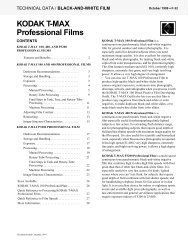Downloaded - Kodak
Downloaded - Kodak
Downloaded - Kodak
Create successful ePaper yourself
Turn your PDF publications into a flip-book with our unique Google optimized e-Paper software.
THEORY GUIDES<br />
The film base has a substratum (subbing layer) that provides adhesion of the light-sensitive emulsion layers to the<br />
film base. Following the subbing layer is a blue-red-sensitive emulsion, an interlayer, a blue-green-sensitive<br />
emulsion, an interlayer, a yellow filter layer, a blue-sensitive emulsion, and finally, a protective gelatin overcoating.<br />
Although the blue-red-sensitive layer is mainly sensitive to red light and the blue-green-sensitive layer to green light,<br />
both of these emulsion layers are sensitive to blue light. The yellow filter layer absorbs the blue component of<br />
exposing light, preventing blue-light exposure of the blue-green-sensitive and blue-red-sensitive emulsion layers.<br />
Film Exposure<br />
The best photographic results are obtained when the film is exposed as recommended in the film instructions. The<br />
processing laboratory must then have a well-controlled process to provide the customer with the best possible slide<br />
or transparency.<br />
During film exposure, latent images form in each of the three emulsion layers. The blue-sensitive emulsion layer<br />
contains a record of the image created by the blue component of the exposing light; the green-sensitive layer contains<br />
the image formed by the green component; and finally, the red-sensitive layer contains the image formed by the red<br />
component of the exposing light. The records of the images all form simultaneously and are exactly superimposed.<br />
26 06APR99 – TG2044-1
















